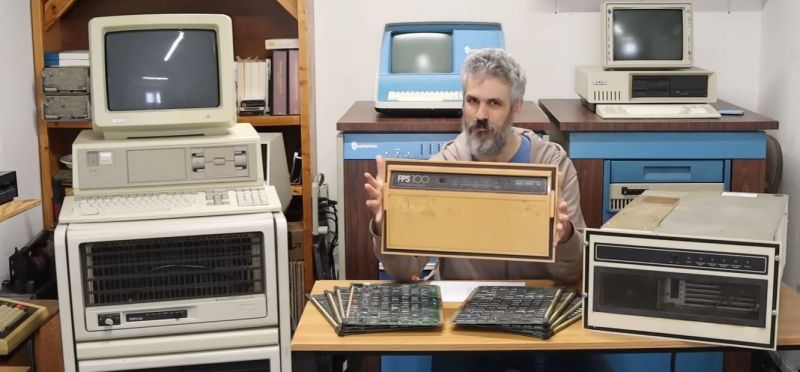With an exciting new year of retrocomputing ahead for [David Lovett] over at the Usagi Electric YouTube channel, recently some new hardware arrived at the farm. Specifically hardware from a company called Floating Point Systems (FPS), whose systems provide computing features to assist e.g. a minicomputer like [David]’s PDP-11/44 system with floating point operations. The goal here is to use a stack of 1980s-era FPS hardware to give the PDP-11/44 MIMD (multiple instructions, multiple data) computing features, which is a characteristic associated with supercomputers.
The FPS hardware is unfortunately both somewhat rare and not too much documentation, including schematics, has been found so far. This is where [David] would love some help from the community on finding more FPS hardware, documentation and any related information so that it can all be preserved.
FPS itself was acquired by Cray in 1991, before SGI took over Cray Research in 1996. As is usual with such acquisitions, a lot of older information tends to get lost, along with the hardware as it gets tossed out over the years by companies and others. So far [David] has acquired an FPS-100 array processor, an interface card for the PDP-11 and an FPS-3000, the latter of which appears to be a MIMD unit akin to the FPS-5000.
Without schematics, let alone significant documentation, it’s going to be an uphill battle to make it all work again, but with a bit of help from us retrocomputer enthusiasts, perhaps this might not be as impossible after all.
















12 Mflops? Is that downhill with a tail wind? A Ryzen 9950 will do 560 Giga flops.
A modern GPU easily outstrips a computer from the 1980s. More news at 7:00
And Oak Ridge’s 2019 Summit will do 148 petaflops which is similarly irrelevant, maybe try comparing contemporary eggs with eggs eh?
“Ai Hardware, Explained’ video unloads on 32 bit floating point standard?
1 Inaccurate multiply mantissa.
2 In addition/subtraction smaller exponent increased to match larger exponent thus discarding fractional values?
Internet posts unload on 64 bit floating point standards?
I can believe it. Ours (a PDP-8) crashed when all eight of us tried to compile at the same time.
the university i went to used to teach the noobs basic on a pdp-8/e running etos. one day i managed to log 13 users in. once the 13th user logged in, etos was never able to make it out of its idle loop.
It is more than exaflops! Gotta have the bandwidth to get data in and out. 128TB memory on a fast switch like nunalink and cray slingshot. Cray 1 at 150MFLOP is now 2ExaFLOP on the Cray at LLNL El Capitan and Musk just bought the First Cray at 1 billion dollars.
The Dec Rainbow sure brings back memories. My first personal computer when in college. Along with a 300 baud modem to get into the school VAX computer, and Turbo Pascal :D .
we got to play with a vax in my high school cs class. of course that was well into the 90s and the machine was maintained only for historical significance.
The quote of the year “if your computer isn’t heavy enough to murder you, can you really call it computing?”
you can murder someone with a microcontroller, you just have to put a bunch of them in a shotgun shell.
“I can kill a man a hundred different ways… with just an ATtiny85. I have been trained by MI5 and Mossad”
Can be done with a 555
This is all overcompensating things, just garrote them with a bit of cable. /s
But your comment was perfect for the audience :-D
“Famous” Czech “home computer” comes to my mind. – https://cs.wikipedia.org/wiki/IQ_151
At 8kg all metal can absolutely kill you. It is basically the same class of computers as Spectrum. Different CPU though – 8080 clone.
If somebody throws a Kaypro at your head corner-first it’s all over man
Hooo. Back in the day. . . . We had an pdp 11/24 providing the operator interface for an industrial chemical site. Amazing, big, slow, amazing. Then we swapped it for a fabulous fast pdp 11/73. The local guy called and said, must be a new hard disc, it’s so small.
Ah Yes, I remember those FPS COprocessors when I was an intern back in mid 80’s at work here.
We had one in the PDP-11 and one in a VAX11/750 for doing calcuations on fourier transforms on noise data.
Contact the Geophysical Society of Houston. The FPS-120B attached to a VAX 11/780 was the canonical seismic processing system. They actively collect and preserve such documents.
I have an FPS unpopulated PCB. It is the huge format at 16 x 20 inches! They used a generic layout of rows of holes for DIP Wire-Wrap, like DEC did for backplanes and many of their production boards. Every unit could be different depending on available parts and hardware changes as long as it interfaced and correctly calculated.
I have schematics for an AP120B, and I was the lead HW designer for the FPS-100. How can I contact Usagai?